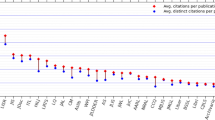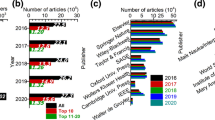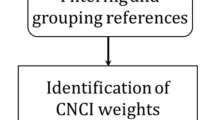Abstract
Considerable efforts and resources are invested by scholarly publishers to advance and promote their journals. These efforts take the form of strategic planning and employed content and publisher editors who provide preprint and post-print assistance to editorial boards, to enhance discoverability and viewership of their journals. However, the effects of these investments are not evaluated, as most assess journals as standalone entities often based on citation metrics. This work aims to quantify the competence of scholarly publishers using a novel metric. The proposed metric, coined as scholarly engagement, is based on a citation-to-view ratio (CVR) garnered by the journals’ articles. The selection of journals takes into consideration broad spectra of journal position across different categories, ranks and timeline. The evaluation uses more than 298,000 articles published in the past ten years. Our quantitative study demonstrates robustness of the proposed metric and its ability to distinguish scholarly publishers.


Similar content being viewed by others
Data Availability
Our codes and data will be made publicly available.
References
Altmetric. “Taylor Francis Group adds altmetric to their journals platform.” 2015. https://www.altmetric.com/press/press-releases/whos-talking-about-research-taylor-francis-group-adds-altmetric-to-their-journals-platform/.
Altmetric. “Emerald Publishing uses Altmetric data and tools to enhance user experience and boost internal communications.” 2020. https://www.altmetric.com/press/press-releases/emerald-publishing-uses-altmetric-data/. Accessed 15 Apr 2021.
Björk BC, Solomon D. Open access versus subscription journals: a comparison of scientific impact. BMC Med. 2012;10(1):1–10. https://doi.org/10.1186/1741-7015-10-73.
Copiello S. The open access citation premium may depend on the openness and inclusiveness of the indexing database, but the relationship is controversial because it is ambiguous where the open access boundary lies. Scientometrics. 2019;121(2):995–1018. https://doi.org/10.1007/s11192-019-03221-w.
Emerald Publishing. 2020. “Your Emerald Team.” 2020. https://www.emeraldgrouppublishing.com/our-services/journal-editorsyour-emerald-team.
Eysenbach G. Citation advantage of open access articles. Edited by Carol Tenopir. PLoS Biol. 2006;4(5): e157. https://doi.org/10.1371/journal.pbio.0040157.
Gadd E, Oppenheim C, Probets S. RoMEO studies 4: an analysis of journal publishers’ copyright agreements. Learn Publ. 2003;16(4):293–308. https://doi.org/10.1087/095315103322422053.
Garfield E. The history and meaning of the journal impact factor. JAMA2. 2006;295(1):90–3.
Giustini AJ, Axelord DM, Lucas BP, Schroeder AR. Association between citations, altmetrics, and article views in pediatric research. JAMA Pediatr. 2020;3(7):e2010784.
Halpenny FG. Responsibilities of scholarly publishers: the responsibility in assessing the merit of scholarly manuscripts is not to individuals but to their work as scholarly endeavour: the context of scholarship is creating new pressures on this process. J Sch Publ. 1993;24(4):223–31.
Halpenny FG, Pincoe R. From catalogue to reader. Toronto: Book and Periodical Council; 1991.
Hicks D, Wouters P, Waltman L, De Rijcke S, Rafols I. Bibliometrics: The leiden manifesto for research metrics. Nature: Nature Publishing Group; 2015. https://doi.org/10.1038/520429a.
Hirsch JE. Does the h index have predictive power? PNAS1. 2007;104(49):19193–8.
Larivière V, Haustein S, Mongeon P. The oligopoly of academic publishers in the digital era. Edited by Wolfgang Glanzel. PLOS ONE. 2015;10(6): e0127502.https://doi.org/10.1371/journal.pone.0127502.
Lemley T, Li J. ‘Big Deal’ journal subscription packages: are they worth the cost? J Electron Resour Med Libr. 2015;12(1):1–10. https://doi.org/10.1080/15424065.2015.1001959.
McGuigan G, Russell R. The business of academic publishing: a strategic analysis of the academic journal publishing industry and its impact on the future of scholarly publishing. 2008. E-JASL 1999–2009 (Volumes 1–10), January. https://digitalcommons.unl.edu/ejasljournal/105.
Morris S. The true costs of scholarly journal publishing. Learn Publ. 2005;18(2):115–26. https://doi.org/10.1087/0953151053584975.
Nicholas D, Jamail HR, Watkinson A, Herman E, Tenopir C, Volentine R, Allard S, Levine K. Do younger researchers assess trustworthiness differently when deciding what to read and cite and where to publish? Int J Knowl Content Dev Technol. 2015;5(2):45–63.
Perianes-Rodríguez A, Olmeda-Gómez C. Effects of journal choice on the visibility of scientific publications: a comparison between subscription-based and full open access models. Scientometrics. 2019;121(3):1737–52. https://doi.org/10.1007/s11192-019-03265-y.
Shanghai Ranking. 2020. “ShanghaiRanking Academic Excellence Survey 2020 Methodology.” 2020. http://www.shanghairanking.com/subject-survey/survey-methodology-2020.html.
White HD, Boell SK, Hairong Yu, Davis M, Wilson CS, Cole FTH. Libcitations: a measure for comparative assessment of book publications in the humanities and social sciences. J Am Soc Inform Sci Technol. 2009;60(6):1083–96. https://doi.org/10.1002/asi.21045.
Winkler, Jason. 2020. “What Do Publishers Do Anyway?” Elsevier. 2020. https://www.elsevier.com/connect/elsevier-chats-what-do-publishers-do-anyway.
Author information
Authors and Affiliations
Corresponding author
Additional information
Publisher's Note
Springer Nature remains neutral with regard to jurisdictional claims in published maps and institutional affiliations.
Supplementary Information
Below is the link to the electronic supplementary material.
Rights and permissions
About this article
Cite this article
Al-Abbas, M., Saab, S.S. Quantifying Publisher’s Competence Through Scholarly Engagement. Pub Res Q 37, 337–346 (2021). https://doi.org/10.1007/s12109-021-09813-w
Accepted:
Published:
Issue Date:
DOI: https://doi.org/10.1007/s12109-021-09813-w




